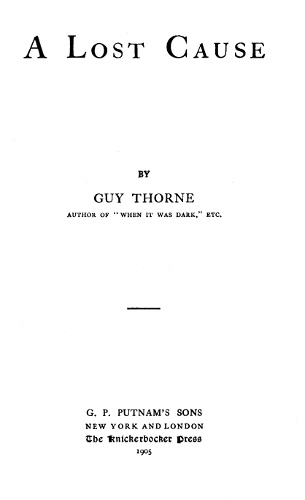
A Lost Cause
BY GUY THORNE
AUTHOR OF "WHEN IT WAS DARK," ETC.
G. P. PUTNAM'S SONS
NEW YORK AND LONDON
The Knickerbocker Press
1905
The Knickerbocker Press, New York
PREFACE
A few words are necessary in preface to this story. After When It WasDark made its appearance, the writer received a great number of lettersfrom his readers, and up to the present moment he still continues toreceive them.
Out of nearly two hundred communications, a large proportion areconcerned not so much with the main issue of the tale, as withcontroversial matters in the Church of England arising from it.
The definitely Catholic[1] tone of the first book aroused, as might beexpected, vigorous protest, and no less vigorous commendation. The fiveor six Bishops—and many other dignitaries—who preached or lecturedabout the story avoided the controversial sides of it. But the writerhas received innumerable letters from the clergy and others to thefollowing effect.
It was pointed out to him that while the extreme "Protestant" party wasconstantly employing fiction as a method of propaganda, churchmen werealmost unrepresented in this way. The Catholic Faith has been bitterlyassailed over and over again in books which are well enough written, andhave sufficient general interest to appeal to the man of the world, whois often indifferent to the points debated.
After considerable discussion, the writing of A Lost Cause wasresolved upon. The author desires to thank those priests who haveassisted him with their counsel and experience, and begs leave toexplain here something of his aims in publishing the tale.
At no period in modern Church history has the Church been assailed withsuch malignance, slander, and untruth as at the present. "Protestantism"within the Church is a lost cause, it is dying, and for just this reasonthe clamour is loudest, the misrepresentation more furious andenvenomed. Shrewd opportunists are taking their last chance of emergingfrom obscurity by an appeal to the ignorance of the general public onChurch matters. Looking round us, we see dozens of uneducated and noisynobodies who have elected themselves into a sort of irregular prelacyand dubbed themselves "Defenders of the Faith," with about as much rightas Napoleon crowned himself emperor.
Church people do not take them very seriously. Their voices are like thecries of hedge-birds by the road, on which the stately procession of theChurch is passing. But the man in the street is more attentive and heenjoys the colour and movement of iconoclasm. He believes also that thebrawlers have right on their side.
But there is an inherent fairness in the man in the street, and, if thisstory reaches him, he will have his opportunity to hear the Catholicside of the argument.
The author begs to state that no single character in this tale is a"portrait" of any living person, or of any real person whatever. Theimaginary folk are designed to be merely typical, their methods areanalogous to much that is going on to-day under the pretences ofpatriotism and love for religious liberty, but that is all.
There will probably be the usual nonsense written, and the braves of"Protestantism" will give the usual war-whoops. Whether this is to beso or not, the author is profoundly indifferent.
He attacks those of the extreme "Protestants" whom he believes to beinsincere and who rebel against the Truth for their own ends. He doesnot say or thi